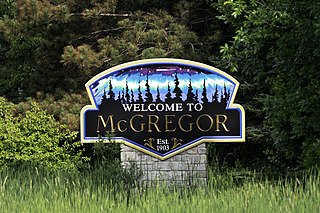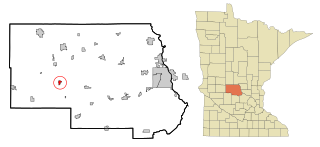
McGrath is a city in Aitkin County, Minnesota, United States. The population was 80 at the 2010 census.

McGregor is a city in Aitkin County, Minnesota, United States. The population was 391 at the 2010 census.
Bull Moose Township is a township in Cass County, Minnesota, United States. The population was 107 as of the 2000 census. This township was named after the Bull Moose Party.
Bungo Township is a township in Cass County, Minnesota, United States. The population was 111 as of the 2000 census. Bungo Township was named for the family of George Bonga.
McKinley Township is a township in Cass County, Minnesota, United States. The population was 130 at the 2000 census. McKinley Township was named for William McKinley, 25th President of the United States.

Isanti is a city in Isanti County, Minnesota, United States. The population was 6,804 at the 2020 census. The name Isanti is composed of two Dakota words: isan ("knife") and ati ("camp"), and refers to the Santee Dakota people.

Harding is a city in Morrison County, Minnesota, United States, along the Platte River. The population was 123 at the 2020 census.

Bluffton is a city in Otter Tail County, Minnesota, United States, along the Leaf River. The population was 210 at the 2020 census.

Clitherall is a city in Otter Tail County, Minnesota, United States. The population was 62 at the 2020 census.

Deer Creek is a city in Otter Tail County, Minnesota, United States. The population was 330 at the 2020 census.

Henning is a city in Otter Tail County, Minnesota, United States. The population was 854 at the 2020 census.

Richville is a city in Otter Tail County, Minnesota, United States. The population was 77 as of the 2020 census.

Urbank is a city in Otter Tail County, Minnesota, United States. The population was 52 at the 2020 census.

McIntosh is a city in Polk County, Minnesota, United States. It is part of the Grand Forks, ND-MN Metropolitan Statistical Area. The population was 606 at the 2020 census.

Gilbert is a city in St. Louis County, Minnesota, United States. The population was 1,799 at the 2010 census. State Highway 37 and State Highway 135 are two of the main routes in Gilbert. Gilbert is part of the Quad Cities, with Virginia, Eveleth, and Mountain Iron. The city is named for Giles Gilbert, who led the exploration of the McKinley mine property in the 1890s.

Tower is a city located in Saint Louis County, Minnesota, United States. As of the 2020 census, the city had a total population of 430. State Highways 1, 169, and 135 are three of the main routes in Tower. Tower is located on the southern shore of Lake Vermilion.

Federal Dam is a city in Cass County, Minnesota, United States, near Leech Lake. The population was 110 at the 2010 census. It is part of the Brainerd Micropolitan Statistical Area.

Spring Hill is a city in Stearns County, Minnesota, United States. The population was 85 at the 2010 census. It is part of the St. Cloud Metropolitan Statistical Area.

Minnesota Lake is a city in Blue Earth and Faribault counties in the State of Minnesota. The population was 661 at the 2020 census. The bulk of the city is in Faribault County; a small part extends into Blue Earth County.
McKinley is an unorganized territory in Kittson County, Minnesota, United States. The population was 42 at the 2000 census.

















